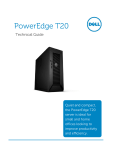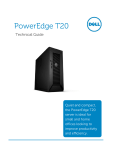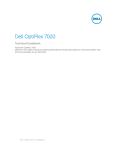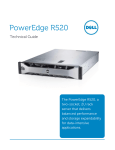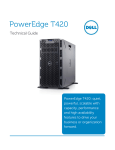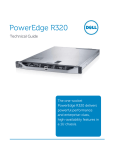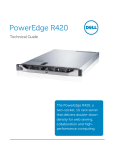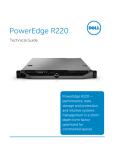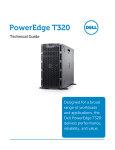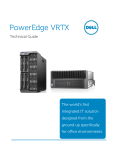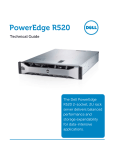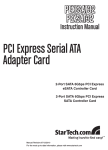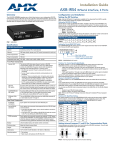Download DELL PowerEdge T20
Transcript
PowerEdge T20 Technical Guide Quiet and compact, the PowerEdge T20 server is ideal for small and home offices looking to improve productivity and efficiency. This document is for informational purposes only. Dell reserves the right to make changes without further notice to any products herein. The content provided is as is and without express or implied warranties of any kind. Dell, the DELL logo and PowerEdge are trademarks of Dell, Inc. Intel, Xeon and Pentium are registered trademarks of Intel Corporation in the U.S. and other countries. Microsoft, Windows and Windows Server are either registered trademarks or trademarks of Microsoft Corporation in the United States and/or other countries. Other trademarks and trade names may be used in this document to refer to either the entities claiming the marks and names or their products. Dell disclaims proprietary interest in the marks and names of others. ©Copyright 2013 Dell Inc. All rights reserved. Reproduction or translation of any part of this work beyond that permitted by U.S. copyright laws without the written permission of Dell Inc. is unlawful and strictly forbidden. December 2013 | Version 2.0 Dell PowerEdge T20 Technical Guide 1 Table of contents 1 System overview ................................................................................................................................................................. 4 New technologies ............................................................................................................................................................. 4 Comparison of selected PowerEdge one-socket tower servers .............................................................................. 4 PowerEdge T20 base fixed configurations ....................................................................................................................5 Specifications ..................................................................................................................................................................... 6 2 Chassis views and features ............................................................................................................................................... 9 Chassis views ...................................................................................................................................................................... 9 Chassis features ............................................................................................................................................................... 10 Quick Resource Locator ................................................................................................................................................. 11 Security features ............................................................................................................................................................... 12 3 Processor ............................................................................................................................................................................ 13 Processor features ............................................................................................................................................................ 13 Supported processors ...................................................................................................................................................... 13 Chipset ................................................................................................................................................................................ 13 4 Memory ...............................................................................................................................................................................14 Supported memory ..........................................................................................................................................................14 5 Storage ................................................................................................................................................................................ 15 Supported hard drives ...................................................................................................................................................... 15 Storage controllers ........................................................................................................................................................... 15 Optical disk drive ..............................................................................................................................................................16 6 Networking and PCIe ....................................................................................................................................................... 17 Integrated NIC controller ................................................................................................................................................ 17 PCIe expansion .................................................................................................................................................................18 7 Power, thermal and acoustics ........................................................................................................................................19 Power management.........................................................................................................................................................19 Power supply unit ............................................................................................................................................................ 20 Thermal and acoustics.................................................................................................................................................... 20 8 Operating systems and virtualization ............................................................................................................................ 21 Supported operating systems......................................................................................................................................... 21 Supported virtualization .................................................................................................................................................. 21 9 Systems management ..................................................................................................................................................... 22 Server and embedded server management ............................................................................................................... 22 Appendix A. Additional specifications .......................................................................................................................... 23 System dimensions and weight .................................................................................................................................... 23 Environmental specifications ........................................................................................................................................ 23 Video specifications ........................................................................................................................................................ 24 USB peripherals ................................................................................................................................................................ 24 Appendix B. Standards compliance ............................................................................................................................. 25 Appendix C. Appendix D. Additional resources................................................................................................................................. 27 System board block diagram .................................................................................................................. 29 Tables Table 1. Table 2. Table 3. New technologies ................................................................................................................................................ 4 Comparing the PowerEdge T110 II to PowerEdge T20 .................................................................................5 PowerEdge T20 configuration options ............................................................................................................ 6 Dell PowerEdge T20 Technical Guide 2 Table 4. Table 5. Table 6. Table 7. Table 8. Table 9. Table 10. Table 11. Table 12. Table 13. Table 14. Table 15. Table 16. Table 17. Table 18. Table 19. Table 20. Table 21. Table 22. Technical specifications ...................................................................................................................................... 6 Chassis configurations ........................................................................................................................................ 9 Chassis features .................................................................................................................................................. 10 Security features .................................................................................................................................................. 12 Supported processors ........................................................................................................................................ 13 DIMMs supported ................................................................................................................................................14 Supported hard drives ........................................................................................................................................ 15 Optical disk drive options ..................................................................................................................................16 Intel Ethernet Connection I217 ......................................................................................................................... 17 PCI card dimensions ...........................................................................................................................................18 Power management features............................................................................................................................19 Power supply specifications ............................................................................................................................. 20 Primary operating systems supported ............................................................................................................. 21 Virtualization support ......................................................................................................................................... 21 PowerEdge T20 dimensions and weight ....................................................................................................... 23 Environmental specifications ........................................................................................................................... 23 Video specifications ........................................................................................................................................... 24 Industry standard documents .......................................................................................................................... 25 Additional resources .......................................................................................................................................... 27 Figures Figure 1. Figure 2. Figure 3. Figure 4. Front panel view and features ............................................................................................................................ 9 Back panel view and features ........................................................................................................................... 10 QRL location ........................................................................................................................................................ 11 PowerEdge T20 system board block diagram .............................................................................................. 29 Dell PowerEdge T20 Technical Guide 3 1 System overview The PowerEdge T20 mini-tower server packs large internal storage capacity and capable performance into a compact, quiet chassis that delivers efficient, worry-free operation. It is an ideal first server for small offices and home offices (SOHO), and excels at storing and sharing, collaboration and productivity, and data protection. With support for up to six internal hard drives, the T20 enables users to simplify their office IT by consolidating business information, images and videos onto a single server, where it can be more easily shared and protected. Powerful Intel® Xeon® or Pentium® multi-core processors drive applications and media faster, for quicker response times and crisp video performance. The T20’s numerous USB ports permit the easy and flexible attachment of external devices, and its small form factor and deskside acoustics allow it to be installed anywhere. New technologies Table 1 details new technologies featured on the PowerEdge T20 server. Table 1. New technologies New technologies Detailed descriptions Intel Xeon processor E3-1200 v3 product family and Intel Pentium processors The Intel Xeon processor E3-1200 v3 product family has advanced features that deliver exceptional performance and value. See the Processor section for a full list of processor options. Intel C226 series chipset The PowerEdge T20 server uses the Intel Platform Controller Hub (PCH) chip. See the Chipset section for details. 1600MT/s DDR3 ECC memory The PowerEdge T20 offers up to 32GB (4 DIMM slots) 2GB/4GB/8GB, 1600MT/s unbuffered ECC memory. See the Memory section for details. Integrated NIC The PowerEdge T20 features Intel Ethernet Connection I217 10/100/1000. See the Networking and PCIe section for details. RAID controller Intel Rapid Storage Controller software RAID is integrated on the PowerEdge T20 with hardware RAID available with an optional storage controller card. Visit the Storage controllers section for details. Comparison of selected PowerEdge one-socket tower servers The PowerEdge T20 builds on the features of the PowerEdge T110 II to offer outstanding performance and value for your small office or home office. Dell PowerEdge T20 Technical Guide 4 Table 2 offers a comparison of the two systems. For the latest information on supported features, visit Dell.com/PowerEdge. Table 2. Comparing the PowerEdge T110 II to PowerEdge T20 Feature PowerEdge T110 II PowerEdge T20 Chassis 1U tower 1U mini-tower Processors Intel Xeon processor E3-1200 product family Intel Xeon processor E31200 v3 product family, Intel Pentium processors Front side bus (FSB) DMI II (Direct Media Interface) Intel Direct Media Interface Memory Up to 32GB (4 DIMMs): 1GB/2GB/4GB/8GB DDR3 up to 1600MT/s Up to 32GB (4 UDIMM) 2GB/4GB/8GB unbuffered 1600MT/s ECC Hard drive bays Up to 4 3.5" SATA/SAS (cabled) hard drives or 6 x 2.5” Up to 6 internal (cabled) hard drives total: Up to four 3.5” SATA hard drives, plus Up to two 2.5” SATA hard drives (require expansion kits) with optional controller card SATA ports/speed (on-board) 5 ports; 5x3Gbps 4 ports; 2x6Gbps; 2x3Gbps PCIe and PCI slots 1x16 (x8, 3.0) 1x8 (x8, 3.0) 1x8 (x4, 2.0) 1x4 (x1, 2.0) 1x16 (x16, PCIe 3.0) 1x16 (x4, PCIe 2.0) 1x1 (x1, PCIe 2.0) 1 PCI slot USB 2 (front), 4 (rear) 2.0 2 (front), 4 (rear) 2.0 2 (front), 2 (rear) 3.0 Internal USB 2 (type-A adapter) 2 (10-pin) LAN on motherboard (LOM) 1 port 1 port Power supplies 305W 80+ 290W Systems management Basic management Intel Active Management Technology (AMT) 9.0 (with Intel Xeon processors) Software RAID PERC S100 Intel Rapid Storage Controller 12.0 PowerEdge T20 base fixed configurations The PowerEdge T20 offers three fixed configurations with options that enable you to tailor your T20 to best suit your needs. Contact your Dell service representative to: Install additional memory and hard drives. Dell PowerEdge T20 Technical Guide 5 Add an operating system or application software. Add external devices, such as laptops, desktop PCs, printers and projectors. Add deployment services to get you up and running. Get support services to keep you running smoothly over time. Table 3 outlines the three base fixed configurations on the T20 as well as additional options. Table 3. PowerEdge T20 configuration options Configuration Description 1 1x Pentium processor 1x 4GB DIMM No hard drive No optical drive 2 1x Pentium processor 1x 4GB DIMM 1x 500GB hard drive No optical drive 3 1x CPU Xeon 1x 4GB DIMM 1x 1TB hard drive No optical drive Options 2 – 4 DIMM nd th 2 – 6 hard drive Optical drive (DVD) Operating system nd th Specifications Table 4 lists the technical specifications for the PowerEdge T20. For the latest information on supported features, visit Dell.com/PowerEdge. Table 4. Technical specifications Feature PowerEdge T20 technical specification Form factor Mini tower (14.17”h x 6.89”w x 17.12”l) Processors Intel Xeon® processor E3-1200 v3 product family Intel Pentium® processors ® Processor sockets 1 socket Dell PowerEdge T20 Technical Guide 6 Feature PowerEdge T20 technical specification Front side bus or HyperTransport Intel Direct Media Interface Cache 3M for dual-core 8M for quad-core Chipset Intel C226 Memory Up to 32GB (4 DIMM slots) 2GB/4GB/8GB 1600MT/s unbuffered with ECC only Memory speed 1333, 1600MT/s Min/Max RAM 2GB/32GB I/O slots 3 PCIe slots: 1 x16 slot (3.0) 1 x16 slot (2.0) 1 x1 slot (2.0) 1 PCI slot RAID controller Intel Rapid Storage Controller 12.0 supporting: SATA 6Gbps (2 ports: SATA0, SATA1) SATA 3Gbps (2 ports+ SATA2, SATA3) 4 SATA connectors support optional additional hard drives and optical drives Drive bays Up to 6 internal (cabled) hard drives in total: Up to 4 3.5” SATA hard drives, plus Up to 2 2.5” SATA hard drives (require expansion kits) with optional controller card Maximum internal storage 13TB (4x 3.5” 3TB; 2x 2.5” 500G) 1 Hard drives 1 3.5” Client SATA (7.2K RPM): 500GB and 1TB 3.5” Enterprise SATA (7.2K RPM): 2TB and 3TB 2.5” SATA 2.5” (10K RPM) 250G and 500G 2.5” SATA SSD: 2.5”, 6Gb, 160G Integrated LOM/NIC Integrated Intel I217 Gigabit Ethernet LAN 10/100/1000 Power supply Cabled 290W auto-sensing USB 2 (front), 4 (rear) 2.0 2 (front), 2 (rear) 3.0 Availability Error Correction Code (ECC) memory; software RAID Dell PowerEdge T20 Technical Guide 7 Feature PowerEdge T20 technical specification Optical drive 5.25” slim optical drive slot Video Integrated Intel HD Graphics P4600 with 2x DP + 1x VGA* Integrated Intel HD Graphics 4600 with 2x DP + 1x VGA * Systems management Intel AMT 9.0 (with Xeon processor only) Operating system Microsoft Windows Server 2012 ® ® *Integrated graphic varies, depending on CPU offerings. Dell PowerEdge T20 Technical Guide 8 2 Chassis views and features The Dell PowerEdge T20 is a one-socket tower server. For additional system views and features, see the Dell PowerEdge T20 Systems Owner’s Manual on Dell.com/Support/Manuals. Chassis views This chassis should be supported in the configurations detailed in Table 5. Table 5. Chassis configurations Number of drive bays Drive types Controller Front control panel Power supply Rack option 4 cabled drive bays 3.5” SATA or 2x 2.5” + 4x 3.5” cabled hard drives Intel Rapid Storage Controller 12.0 LED Cabled 350W No Figure 1 shows the features on the front of the T20 chassis with the USB connectors and other components and features described in this guide. Figure 1. Front panel view and features POWER BUTTON/POWER LIGHT OPTICAL DRIVE BAY (OPTIONAL) HEADPHONE INPUT MICROPHONE INPUT USB 3.0 CONNECTOR (2) USB 2.0 CONNECTOR (2) DRIVE ACTIVITY LIGHT Dell PowerEdge T20 Technical Guide 9 Figure 2 shows the features on the back of the T20 chassis with components and features described in this guide. Figure 2. Back panel view and features POWER SUPPLY DIAGNOSTIC LIGHT SECURITY CABLE SLOT POWER CONNECTOR PADLOCK RING BACK PANEL CONNECTORS EXPANSION CARD SLOTS slot Chassis features Table 6 lists the PowerEdge T20’s many chassis features. For additional information, see the Dell PowerEdge T20 Systems Owner’s Manual on Dell.com/Support/Manuals. Table 6. Chassis features Feature Description Power button ACPI-compliant power button with an integrated green power LED Front bezel Covers the server’s front-loading hard drives and locks for security NMI button Used to troubleshoot software and device driver errors; use only if directed by qualified support personnel or by the operating system's documentation System identification button Buttons on the back and front of a system to help identify the unit in a data center environment Dell PowerEdge T20 Technical Guide 10 Feature Description Up to 4x 3.5” SATA hard drives, plus Hard drives Up to 2x 2.5” SATA hard drives (require expansion kits) with optional controller card USB connectors Connects USB devices to the server Information tag Slide-out label panel for recording system information Video connector Connects a monitor to the server; 1 port on the back of the tower chassis or a port on both the front and back of the rack chassis LCD panel and buttons Displays system ID, status information and system error messages; 2 navigation buttons on the hot-plug chassis to scroll through the menu on the LCD and 1 select button Optical drive (optional) Optional half-height DVD or DVD+RW drive Power supply units Supplies power to the server Power supply indicators Indicates whether server has power NIC indicators Indicates network activity and status PCIe slots Connects PCIe expansion cards to the server Ethernet connectors Connects integrated 10/100/1000 NICs to the server Serial connector Connects a serial device to the server Quick Resource Locator Dell PowerEdge 12th generation servers feature a Quick Resource Locator (QRL) — a model-specific Quick Response (QR) code that is located inside the T20 chassis cover (see Figure 3). Use your smartphone to access the Dell QRL app to learn more about the server. Figure 3. QRL location This QRL code allows you to: View step-by-step videos, including overviews of system internals and externals, as well as detailed, concise, task-oriented videos and installation wizards. Locate reference materials, including searchable owner’s manual content, LCD diagnostics and an electrical overview. Look up your service tag so you can quickly gain access to your specific hardware configuration info and warranty information. Contact Dell directly (by link) to get in touch with technical support and sales teams and provide feedback to Dell. Dell PowerEdge T20 Technical Guide 11 These codes provide an easy way to retrieve the critical support information you need when you need it, making you more efficient and effective in managing your hardware. Security features The latest generation of PowerEdge servers has the features listed in Table 7 to help ensure the security of your data center. Table 7. Security features Security feature Description Cover latch A tooled latch is integrated in the top cover to secure it to the rack chassis. Front bezel A metal bezel is mounted to the chassis front to provide the Dell ID. A lock on the bezel is used to protect un-authorized access to hard drives. System status is viewable on the LCD or LED panel when the bezel is installed. TPM The Trusted Platform Module (TPM) is used to generate/store keys, protect/authenticate passwords and create/store digital certificates. It also supports the Intel Xeon TXT functionality. TPM can also be used to enable the BitLocker™ hard drive encryption feature in Windows Server 2008. TPM 1.2 is supported. No TPM version is available for China or Russia. Power-off security BIOS has the ability to disable the power button function. Intrusion alert An internal switch is used to detect chassis intrusion. Secure mode BIOS has the ability to enter a secure boot mode through system setup. This mode includes the option to lock out the power and NMI switches on the control panel or set up a system password. . Dell PowerEdge T20 Technical Guide 12 3 Processor The Dell PowerEdge T20 offers Intel Pentium processors and the next-generation Intel Xeon processor E3-1200 v3 product family, which features enhanced media, graphics capabilities, flexibility and enhanced security. Manufactured on industry-leading 22 nm process technology with 3D Tri-Gate transistors, the Intel Xeon processor E3-1200 v3 family offers numerous advancements over the Intel Xeon processor E3-1200 v2 family. Processor features The Intel Xeon processor E3-1200 v3 product family features include: Enhanced energy efficiency and performance Support for ECC memory for better data integrity, reliability and system uptime High-end media and graphics capabilities for devices that display videos, 2D and 3D graphics and interactive content Intel Turbo Boost Technology 2.0 to accelerate processor and graphics performance for peak loads Intel Hyper-Threading Technology for faster performance for demanding business applications Continued improvements to both Intel TXT and AES-NI help to better protect systems and data Supported processors Table 8 lists the Intel processors supported by the PowerEdge T20. For the latest information on supported processors, visit Dell.com/PowerEdge. Table 8. Supported processors Model Speed TDP Cache Cores/ threads Max memory speed Turbo Xeon E3-1225 v3 3.2GHz 84W 8MB 4/8 1600MT/s Yes Pentium G3220 3.0GHz 54W 3MB 2/2 1333MT/s MP For more information supported Intel processors, visit Intel.com. For information on processor installation and configuration, see the Dell PowerEdge T20 Systems Owner’s Manual on Dell.com/Support/Manuals. Chipset The Intel C226 chipset is implemented on the Dell PowerEdge T20. For more information, visit Intel.com. Dell PowerEdge T20 Technical Guide 13 4 Memory More options are available for the Dell PowerEdge 12th generation servers than in previous generations — more capacity choices and more frequency choices. The PowerEdge T20 supports up to 32GB of memory with speeds of up to 1600MT/s, providing high performance in a variety of applications. Supported memory The T20 supports memory speeds of 1600MT/s and 1333MT/s, depending on the DIMM types installed and the configuration. All memory on all processors and channels runs at the same speed and voltage. By default, the system runs at the highest speed for the channel with the lowest DIMM voltage and speed. The T20 supports the DIMMs listed in Table 9. For the latest information on supported memory, visit Dell.com/PowerEdge. Table 9. Capacity Speed DIMMs supported Type Ranks per DIMM 4GB 1333/1600MT/s UDIMM 1 4GB 1333/1600MT/s UDIMM 1 4GB 1333/1600MT/s UDIMM 2 8GB 1333/1600MT/s UDIMM 2 8GB 1333/1600MT/s UDIMM 1 8GB 1333/1600MT/s UDIMM 2 16GB 1333/1600MT/s UDIMM 2 16GB 1333/1600MT/s UDIMM 2 32GB 1333/1600MT/s UDIMM 2 Dell PowerEdge T20 Technical Guide 14 5 Storage The Dell PowerEdge T20 supports up to four 3.5-inch hard drives and up to two 2.5-inch hard drives. 4x 3.5-inch cabled drive bays from motherboard SATA connector 3x 3.5-inch cabled SATA, plus SATA optical disk drive device from motherboard SATA connector 2x 2.5-inch cabled SATA via add-on storage controller, plus 4x 3.5-inch cabled SATA from motherboard SATA connector Supported hard drives Table 10 lists the PowerEdge T20 hard drive options. For additional information, see Dell.com/PowerEdge. Table 10. Form factor Supported hard drives Type Speed (rpm) Capacities SATA 10K 250GB, 500GB SATA SSD 6Gb 160GB SATA 7.2K 500GB, 1TB Enterprise 7.2K 2TB, 3TB 2.5” 3.5” Storage controllers The PowerEdge T20 supports Intel Rapid Storage Controller 12.0 software RAID and hardware RAID from the optional storage controller card available at Dell.com. The PEXSAT32 2-Port PCIe SATA 6GB controller card offers simple connectivity between a host computer and SATA 3.0 devices — a costeffective solution for connecting high-speed storage, such as High RPM hard drives and solid state drives (SSD), which in turn allows for easier data backups and archiving. StarTech Part #: PEXSAT32 Dell Part#: A4046565 Note: Additional SATA cables are required to connect the card with fourth and fifth hard drives and an additional power extension cable is required to connect the system power to these drives. Dell PowerEdge T20 Technical Guide 15 Optical disk drive The PowerEdge T20 supports one internal slim optical drive and is able to boot from any internal optical drive. Table 11 lists supported optical disk drive options. Table 11. Optical disk drive options Optical disk drive Supported Slimline 6X Blu-ray Writer SATA 1.5Gbps Yes Slimline 8X DVD+/-RW1 SATA 1.5Gbps Yes Slimline 8X DVD-ROM2 SATA 1.5Gbps Yes The PowerEdge T20 server supports “no optical drive” configurations, support for optional internal DVD-ROM (SATA) and support for optional internal DVD+RW (SATA). Note: An additional power extension cable is required to connect the system power to fourth and fifth hard drives, and an optical disk drive. Dell PowerEdge T20 Technical Guide 16 6 Networking and PCIe The Dell PowerEdge T20 offers balanced, scalable I/O capabilities, including integrated PCIe 2.0and 3.0-capable expansion slots. Integrated NIC controller The PowerEdge T20 has an integrated Intel Ethernet Connection I217 chip for performanceenhancing features: Cost-optimized single GbE (1GbE) Small 6x6 mm quad-flat, no-lead (QFN) package Intel power optimizer 500mW TDP with typical ~ 400mW GbE Energy-Efficient Ethernet (EEE) Table 12 outlines additional specifications of the Intel Ethernet Connection I217. Table 12. Features Network transfer mode Intel Ethernet Connection I217 External connector type RJ45 Data rates supported 10/100/1000Mbps Controller bus architecture PCIe-based interface for S0 state, SMBus for Sx low power state Integrated memory No Data transfer mode (example Bus-Master DMA) No Power consumption (full operation per data rate connection speed) 535mW (Maximum) Power consumption (standby operation) 176mW (Maximum) IEEE standards compliance (example 802.1P) 802.3 Boot ROM support EEPROM (located in SPI) Network transfer rate 10BASE-T (full-duplex) 20Mbps 100BASE-TX (half-duplex) 100Mbps 100BASE-TX (full-duplex) 200Mbps 1000BASE-T (full-duplex) 2000Mbps Dell PowerEdge T20 Technical Guide 10Mb (full/half-duplex) 100Mb (full/half-duplex) 1000Mb (full-duplex) 17 Environmental Operating temperature 0° to 85°C (32° to 185°F) Operating humidity 20% to 80% (noncondensing) Operating system driver support Microsoft Windows 7 32/64, Microsoft Windows 8 32/64 Manageability Wake On LAN (WOL) Pre-boot eXecution Environment (PXE) 2.1 Management capabilities and alerting Intel Standard Manageability Intel Core 2 Duo/Quad Processor with vPro Technology PCIe expansion PCIe connectivity is integrated with the processor. The T20 supports up to four PCIe slots. PCI card dimensions are outlined in Table 13. 1x PCIe x16 slot 3.0 1x PCIe x16 (wired x4) slot 2.0 1x PCIe x1 slot 2.0 1x PCI 32/33 slot Table 13. PCI card dimensions Type Voltage supported PCIe x16 3.0 3.3V/12V 4.38 in/11.13 cm 6.6 in/16.77 cm full height half length 75* Graphics Gigabit NIC Parallel/Serial PCIe x1 2.0 3.3V/12V 4.38 in/11.13 cm 6.6 in/16.77 cm full height half length 25 Gigabit NIC Parallel/Serial PCI 3.3V/5V/12V/- 4.38 in/11.13 cm 6.6 in/16.77 cm 12V full height half length 25 1394 PCIe x16 (x4) 2.0 3.3V/12V 25* Graphics, Gigabit NIC Parallel/Serial Max height Max length 4.38 in/11.13 cm 6.6 in/16.77 cm full height half length Dell PowerEdge T20 Technical Guide Max wattage Cards supported 18 7 Power, thermal and acoustics Lower overall system-level power draw is a result of breakthrough system design. The Dell PowerEdge T20 server maximizes performance per watt through a combination of power and cooling, energy-efficient technologies and tools. Additionally, the PowerEdge T20 has an extensive collection of sensors that automatically track thermal activity, which helps regulate temperature, thereby reducing server noise and power consumption. Power management Table 14 summarizes power management features on the PowerEdge T20. Table 14. Power management features Feature Type Enable/Status/Ctrl bit location ACPI mode switch Fixed PCH The operating system uses the SCI_EN bit in PCH to switch from legacy mode to ACPI mode. Sleep states Fixed PCH Supported states: S0 (Working), S4-OS (‘Hibernation’), and S5 (Soft-off). S1 (also called ‘standby’ or ‘suspend’) and S3 are not supported. Power button Fixed PCH In ACPI mode, the operating system has control of the power button. In non-ACPI mode, SMI handler owns power button events. Real-time clock (RTC) Fixed PCH The operating system is able to configure the system to wake on the RTC alarm. Power management timer Fixed PCH PCH 32-bit power management timer is used. Power management event (PME) Generic PCH When a device signals PME, the system wakes (if necessary), the OS detects the event, and a Delldefined ASL routine handles the event. Wake-on-LAN is one example of a PME. DBS N/A Processor MSRs This feature does P state transition under Windows. C state support N/A Processor and PCH registers This feature allows multiple C state support for the processor. This feature will work under Windows and ACPI OS that understand C states. Dell PowerEdge T20 Technical Guide Description 19 Power supply unit The PowerEdge T20 includes a single 290W cabled auto-sensing power supply that provides power to the T20 planar, the four internal hard drive bays and the two 2.5” internal drive bays. Table 15 details power supply specifications. Table 15. Power supply specifications Specification 290W AC Current consumption 10–5A Supply voltage Frequency Heat dissipation (BTU/hr max.) 1 100–240V AC 50/60Hz 989 Thermal and acoustics Optimized thermal management makes the PowerEdge T20 cool and quiet. Benefiting from a smart cooling thermal control algorithm, the T20 offers both high performance and quiet acoustics across a wide range of ambient temperatures (5°C ~ 35°C). Though the fan-induced sound is inevitable for cooling purposes, it is controlled to be smooth and quiet. In a typical office environment (~45dBA), the sound is almost unnoticeable. Dell PowerEdge T20 Technical Guide 20 8 Operating systems and virtualization The Dell PowerEdge T20 supports a wide range of industry-standard operating systems and virtualization software. Supported operating systems Primary operating systems supported the primary operating systems supported on the PowerEdge T20. For the latest information on supported operating systems, see Dell.com/OSsupport. Table 16. Primary operating systems supported Operating system Platform Edition Microsoft Windows Server 2012 X64 Foundation Essentials Standard Supported virtualization Table 17 highlights the virtualization support for the T20. Table 17. Virtualization support Operating systems Factory options Internal dual SD module install support Red Hat Enterprise Virtualization 6.5 DIB Yes DIB = drop-in-box Dell PowerEdge T20 Technical Guide 21 9 Systems management The PowerEdge T20 offers Intel Active Management Technology (AMT). Intel Xeon platforms equipped with Intel AMT can be managed remotely, regardless of whether they are powered up or have a functioning operating system. Intel AMT Manageability Server 9.0 features include: Intel Intelligent Power Node Manager Power Management service assisting BMC Boot control Power state management Hardware/software inventory Hardware alerting Audit logs Microsoft Network Access Protection (NAP) Fast-call for help; remote schedule maintenance Measured AMT KVM remote control and re-direction/enhancements PC alarm clock Firmware upgrade/downgrade Host-based setup and configuration AMT graceful shutdown Server and embedded server management The Dell PowerEdge T20 is Intelligent Platform Management Interface (IPMI) v2.0 compliant. Dell PowerEdge T20 Technical Guide 22 Appendix A. Additional specifications System dimensions and weight Table 18 details the dimensions and weight of the Dell PowerEdge T20. Table 18. PowerEdge T20 dimensions and weight PowerEdge T20 Height 14.17 in/36 cm Width 6.89 in/17.5 cm Depth 17.12 in/43.5 cm Weight 18.72 lbs/8.49 kg Environmental specifications Table 19 offers environmental specifications of the Dell PowerEdge T20. Table 19. Environmental specifications Temperature Operating 5° to 35°C (41° to 95°F) Non-operating (Storage) –40° to 65°C (–40° to 149°F) Relative humidity 20% to 80% (non-condensing) Maximum vibration Operating 0.26Grms random at 5 to 350Hz Non-operating 2.2Grms random at 5 to 500Hz Maximum shock Operating Bottom half-sine pulse with a change in velocity of 50.8 cm/sec (20 inches/sec) Non-operating 105G half-sine pulse with a change in velocity of 133 cm/sec (52.5inches/sec) Maximum altitude Operating –15.2 to 3048 m (–50 to 10,000 ft) Non-operating –15.2 to 10,668 m (–50 to 35,000 ft) Dell PowerEdge T20 Technical Guide 23 Video specifications Video specifications of the Dell PowerEdge T20 are detailed in Table 20. Table 20. Video specifications Graphic/Video options Integrated Intel HD Graphics P4000 with 2x DP + 1x VGA X Integrated Intel HD Graphics 4000 with 2x DP + 1x VGA X USB peripherals USB peripherals are supported through the front and back USB ports on the T20. These ports are USB 3.0 compliant. Dell PowerEdge T20 Technical Guide 24 Appendix B. Standards compliance The PowerEdge T20 system conforms to the industry standards in Table 21. Table 21. Industry standard documents Standard URL for information and specifications ACPI Advance Configuration and Power Interface Specification, v2.0c acpi.info Ethernet IEEE 802.3-2005 standards.ieee.org/getieee802/802.3.html HDG Hardware Design Guide Version 3.0 for Microsoft Windows Server microsoft.com/whdc/system/platform/pcdesign/desguide/serverdg.msp x IPMI Intelligent Platform Management Interface, v2.0 intel.com/design/servers/ipmi DDR3 Memory DDR3 SDRAM Specification, Rev. 3A jedec.org/download/search/JESD79-3C.pdf LPC Low Pin Count Interface Specification, Rev. 1.1 developer.intel.com/design/chipsets/industry/lpc.htm PCI Express PCI Express Base Specification Rev. 2.0 and 3.0 pcisig.com/specifications/pciexpress PMBus Power System Management Protocol Specification, v1.2 pmbus.info/specs.html SAS Serial Attached SCSI, v1.1 www.t10.org SATA Serial ATA Rev. 2.6; SATA II, SATA 1.0a Extensions, Rev. 1.2 sata-io.org SMBIOS System Management BIOS Reference Specification, v2.7 dmtf.org/standards/smbios TPM Trusted Platform Module Specification, v1.2 trustedcomputinggroup.org Dell PowerEdge T20 Technical Guide 25 UEFI Unified Extensible Firmware Interface Specification, v2.1 uefi.org/specs USB Universal Serial Bus Specification, Rev. 2.0 usb.org/developers/docs Windows Logo Windows Logo Program System and Device Requirements, v3.10 microsoft.com/whdc/winlogo/hwrequirements.mspx Dell PowerEdge T20 Technical Guide 26 Appendix C. Additional resources Table 22 provides a list of documents and websites that provide for more information on the Dell PowerEdge T20. Table 22. Additional resources Resource Description of contents Location Dell PowerEdge T20 Owner’s Manual This manual, available in PDF format, provides the following information: Chassis features System setup program System messages System codes and indicators System BIOS Remove and replace procedures Troubleshooting Diagnostics Jumpers and connectors Dell.com/Support/Manuals Dell PowerEdge T20 Getting Started Guide This guide is printed and shipped with the system, and is also available in PDF format on the Dell support site. This guide provides information on the following: Initial setup steps Key system features Technical specifications Dell.com/Support/Manuals Cable Management Arm Installation This printed document is provided with the CMA kits. The document provides the instructions for installing the cable management arm on the rails. Dell.com/Support/Manuals Information Update This document is printed and shipped with the system, and is also available in PDF format on the Dell support site. This document provides information on system updates. Dell.com/Support/Manuals System Information Label The system information label documents the system board layout and system jumper settings. Text is minimized due to space limitations and translation considerations. The label size is standardized across platforms. Inside the system chassis cover Quick Resource Locator (QRL) This code on the chassis can be scanned by a phone application to access additional information and resources for the server, including videos, reference materials, service tag information and Dell contact information. Inside the system chassis cover Power and cooling Provides details for improving energy efficiency in the data center. Dell.com/PNC Operating system matrix for Dell PowerEdge Provides updated information on which operating systems are available on which PowerEdge systems. Dell.com/OSsupport Dell PowerEdge T20 Technical Guide 27 Resource Description of contents Location Processor and chipset Provides more information about the Intel processors and chipset. Intel.com Power distribution unit (PDU) Provides help selecting a rack-based power distribution unit. DellPDU.com Uninterruptible power supply (UPS) Provides help selecting an uninterruptible power supply model. DellUPS.com Volatility information Contact your Dell sales representative. Dell.com/Support/Manuals systems Dell PowerEdge T20 Technical Guide 28 Appendix D. System board block diagram Figure 4. PowerEdge T20 system board block diagram Intel Xeon processor E3-1200 v3 product family Intel C226 Chipset Dell PowerEdge T20 Technical Guide 29






























